Seen from the front, the building is in three parts: the central section has an ornate portico, dating from 1921, having replaced a wide gateway leading to the yard and stables at the rear. Above the portico is the royal coat of arms of Princess Mary of Teck, later Queen Mary, royal consort to George V. The hotel was given permission to display the royal arms after the princess’s 1891 visit, since when it has been called The Royal Hop Pole.
Framed photographs and text about the Royal Hop Pole.

The text reads:
Seen from the front, this grade II listed building is in 3 parts. The central section has an ornate porch supported by slender iron columns, which dates from 1921 and replaced a wide gateway leading to the yard and stables at the rear.
Above the porch is the royal coat of arms of Princess Mary of Teck, later Queen Mary, Royal consort of King George V. The hotel was granted permission to display the royal arms after the princess visited in 1891. It has since been called The Royal Hop Pole.
Before the late 18th Century, The Hop Pole was known as The New Inn. Two centuries earlier, around 1545, it was known as the Crone, or Crown, and the occasional meeting place of the towns cordwainers (boot & shoe makers) who traded in Church Street.
Above: Princess Mary of Teck, and her husband King George V
Right: The Hop Pole, Royal Hotel, with Lister Martin, the proprietor 1899-1907 outside.
An old advert for the Hop Pole Hotel and Riverside Private Hotel.
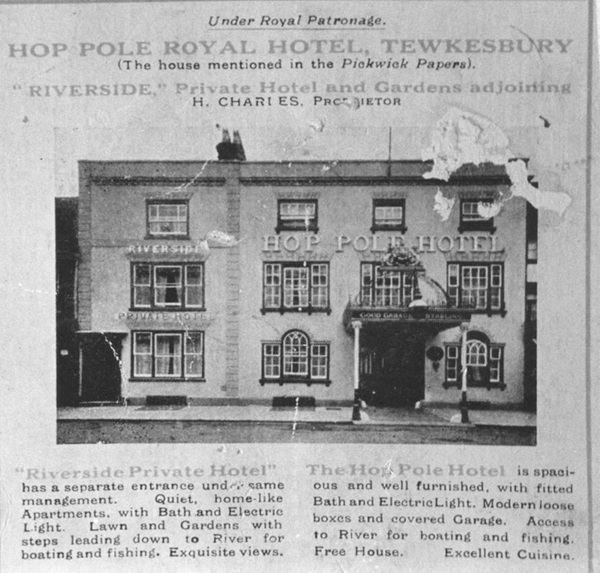
The advert reads:
Riverside Private Hotel has a separate entrance under same management. Quiet, home-like Apartments, with Bath and Electric Light. Lawn and Gardens with steps leading down to River for boating and fishing. Exquisite views.
The Hop Pole Hotel is spacious and well furnished, with fitted Bath and Electric Light. Modern loose boxes and covered Garage. Access to River for boating and fishing. Free House. Excellent Cuisine.
An old menu from Friday 19th August 1939.

Available on the menu that day include dishes such as: smoked salmon, chicken patties and caramel pudding.
An old photograph of the courtyard, which was the coaching entrance.

An internal photograph of the Medieval Hall.


The hall is believed to date back to 1380.
A close up of the original beams in the Medieval Hall.

An artist’s impression of the Medieval Hall during its original use.
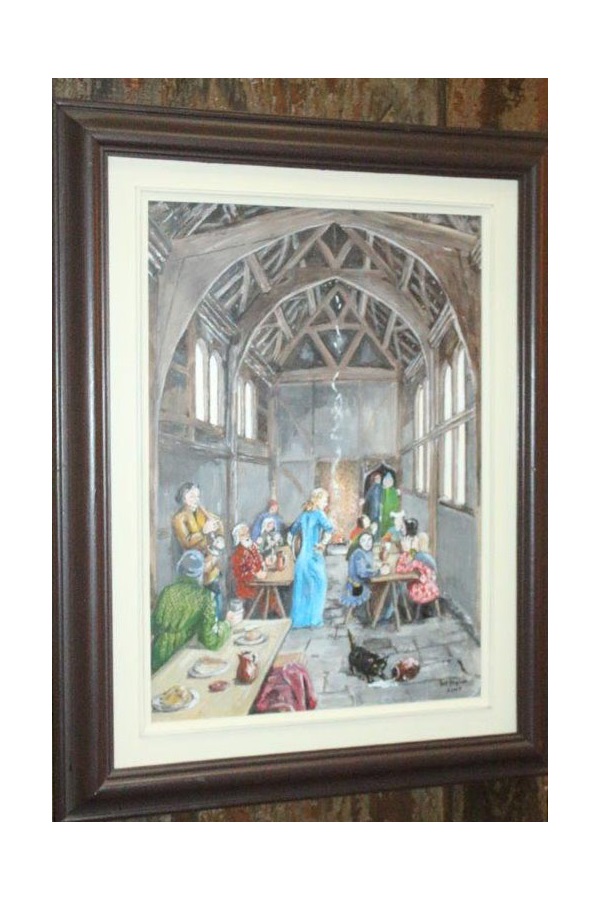
A framed photograph and text about how Medieval Hall’s paintings were restored.
.jpg?h=778&&w=600&la=en&hash=4042916A426CC80BFECDD695960C3E960CE2621A)
The text reads:
During the recently completed building works, four areas of original painted decoration were discovered and conserved: two sections of wall painting in room 107, one area of wall painting in room 108 and the painted timber structure of the so called Banqueting Hall.
Conservation treatment consisted of removal of multiple layers of lime wash and old repair plaster to reveal the underlying paintings, using scalpels. Flaking paint was reattached as for the hall and holes in the plaster were filled with new lime mortar and toned down with coloured lime washes to blend with the original decoration. The whole north wall and the smaller panel have been protected behind glass panels, in order for the room to be used safely.
The conservation work was carried out by Mark Perry of The Perry Lithgow Partnership Ltd, with the assistance of Bianca Madden, Doug Thorp and Peter Martindale. For anyone who is interested in further information regarding the wall paintings and their conservation, a copy of the complete conservation record is held by Tewkesbury Town Council.
Medieval wall paintings found in a couple of the hotel rooms.

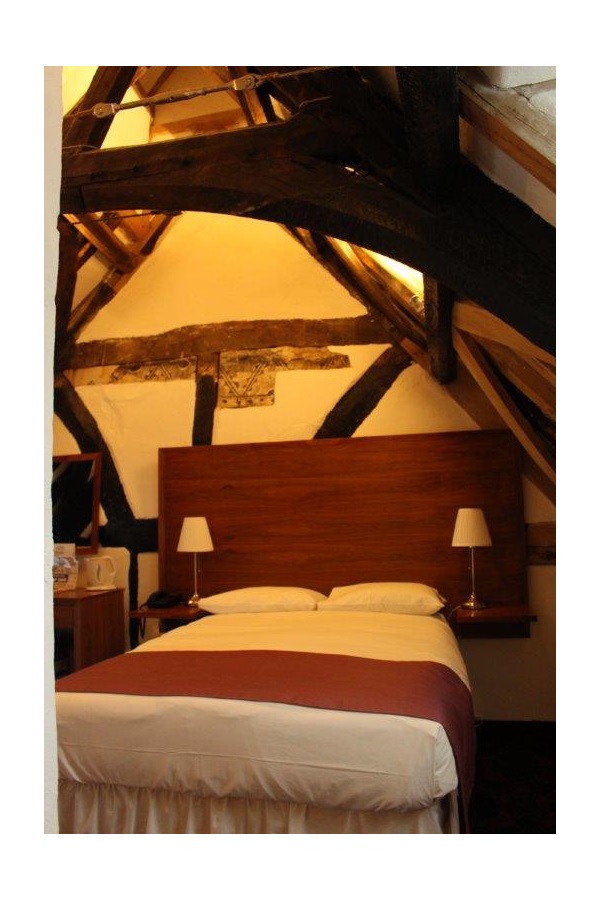
A large piece of Medieval wall painting that is now covered to help maintain it.
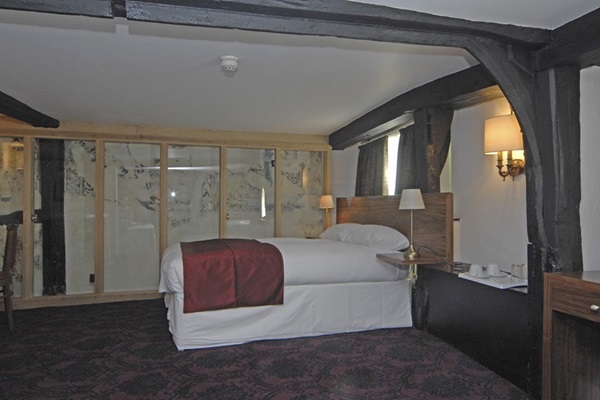
A Medieval wall painting found outside one of the hotel rooms.

A framed piece of text about the wall paintings in room 108.
.jpg?h=824&&w=600&la=en&hash=C08B3AAE79E6FA12D0E8F6C0A6E8FE54899C38DC)
The text reads:
The Wall painting in the room adjoining the hall bears remarkable similarities to the Hall Decoration and is therefore thought to be coeval. It uses the same decorative patterns of triangles with floral motifs, although in this case the scheme is in black on a white lime wash ground over the original lime wash plaster. As in the Hall, the presence of the wall painting only became apparent when the false ceiling was removed, revealing a section of painted plaster in the roof space. The decoration has only been partly revealed because the remaining covering plaster is too well adhered to the paint layer to make full uncovering a viable option at this stage. It does however give an impression of how the room may originally have appeared.
A framed piece of text about the wall paintings in room 107.
.jpg?h=904&w=600&la=en&hash=E4752708C72E91CFD717FB1F70640041E3193116)
The text reads:
Adjacent to the entrance to room 107 is a smaller panel of wall painting which was only discovered during the building alterations. This was revealed from under numerous coats of lime wash and is in remarkably good condition. Again there are the remains of three periods of decoration, including small traces of the later blue scheme. However, the most exciting discovery was the uncovering of a small figure, set against a very decorative background of flowers, foliage and architectural motifs. The image is slightly confused by significant amounts of the second scheme; however, it is important that all the historic decorative schemes were retained as far as possible as each is indicative of the development of the building over the years.
There are also numerous traces of a later, 17th century bright blue scheme of arches with pendants, particularly adjacent to the window. Within at least one of the arches are the remains of a bright red lion, with the shadow of a larger lion also visible underlying it. From the other remains of this scheme it seems it originally extended around the entire room. Analysis of a paint sample has identified the blue pigment as indigo.
A plaque about Mr Pickwick and companions.
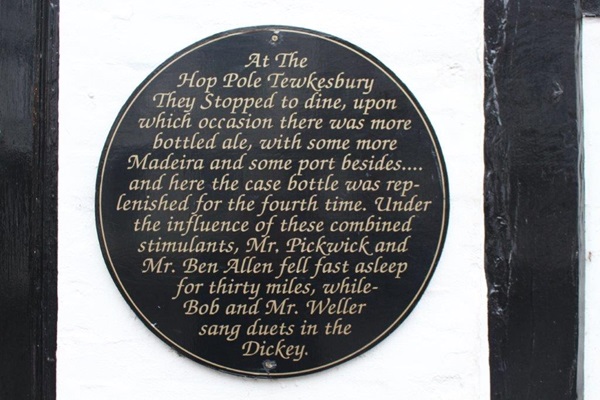
The plaque reads:
At The Hop Pole Tewkesbury they stopped to dine, upon which occasion there was more bottled ale, with some more Madeira and some port besides… and here the case bottle was replenished for the fourth time. Under the influence of these combined stimulants, Mr Pickwick and Mr Ben Allen fell fast asleep for thirty miles, while Bob and Mr Weller sang duets in the Dickey.
Framed photographs and text about Mr Pickwick.
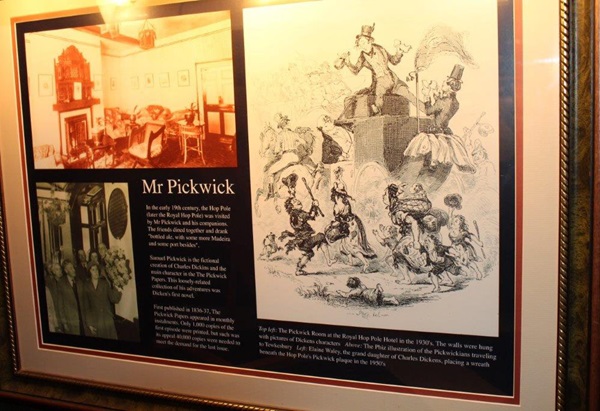
The text reads:
In the early 19th century, the Hop Pole (later the Royal Hop Pole) was visited by Mr Pickwick and his companions. The friends dined together and drank ‘bottled ale, with some more Madeira and some port besides’.
Samuel Pickwick is the fictional creation of Charles Dickens and the main character in The Pickwick Paper. This loosely-related collection of his adventures was Dickens first novel.
First published in 1836-37, The Pickwick Papers appeared in monthly instalments. Only 1000 copies of the first episode were printed, but such was its appeal 40,000 copies were needed to meet the demand for the last issue.
Top left: The Pickwick Room at the Royal Hop Pole Hotel in the 1930’s. The walls were hung with pictures of Dickens characters.
Above: The Phiz illustration of the Pickwickians traveling to Tewkesbury.
Left: Elaine Waley, the granddaughter of Charles Dickens, placing a wreath beneath the Hop Pole’s Pickwick plaque in the 1950’s.
An antique table – which most recently featured on Antiques Roadshow!

An original Tudor fireplace.

External photograph of the building – front.
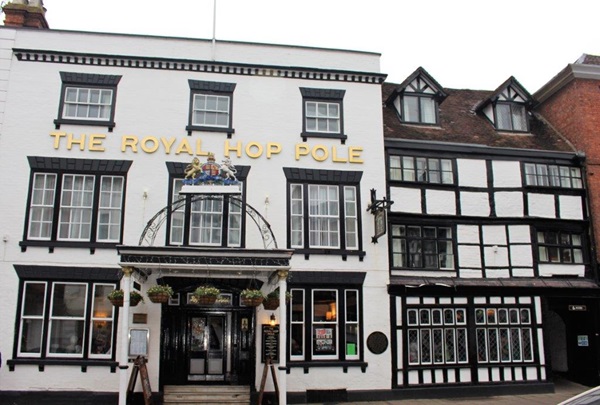
The royal coat of arms above the main entrance.
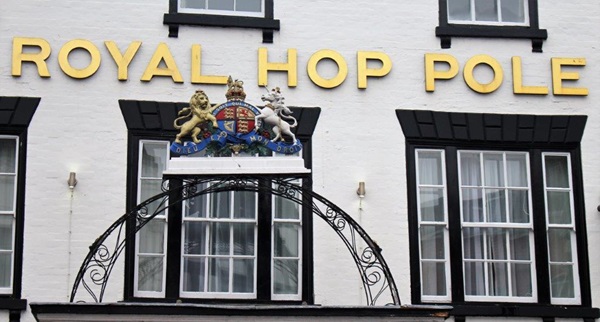
The hotel was given permission to display the royal arms after the princess’s 1891 visit.
Thankyou to the hotel manager Emma, and her team, for all their hard work gathering the information to display on this page.
Extract from Wetherspoon News Spring 2017.
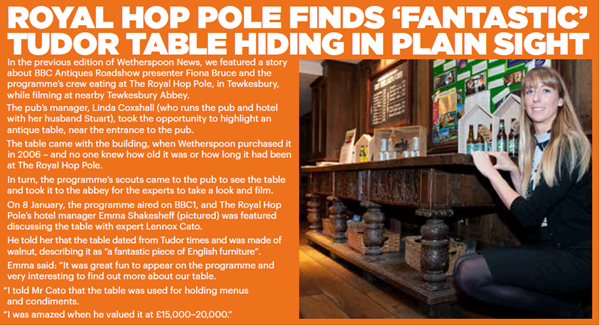
If you have information on the history of this pub, then we’d like you to share it with us. Please e-mail all information to: pubhistories@jdwetherspoon.co.uk